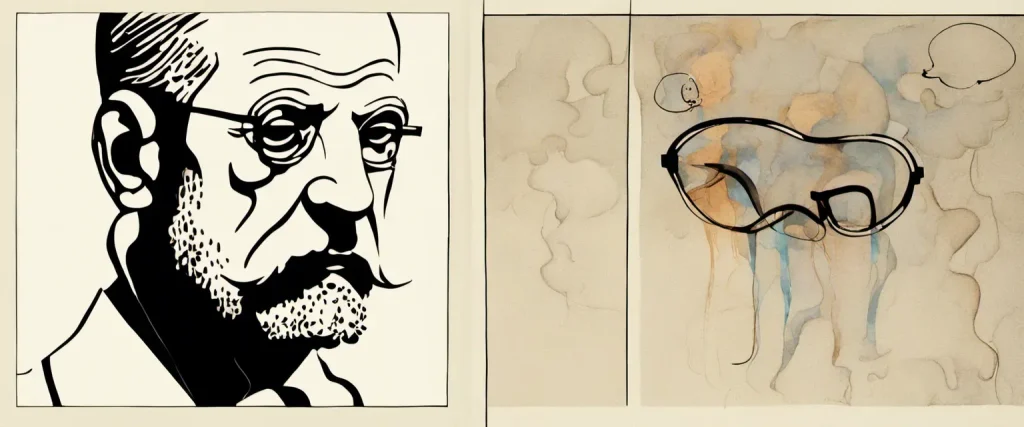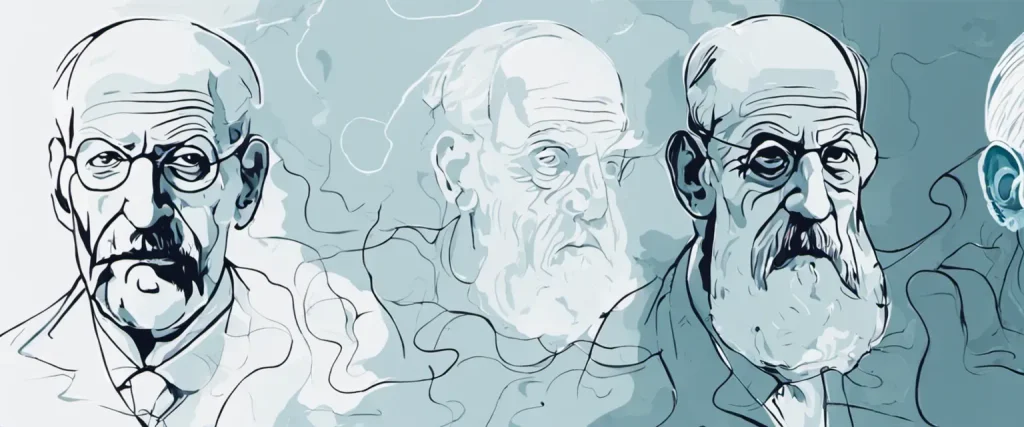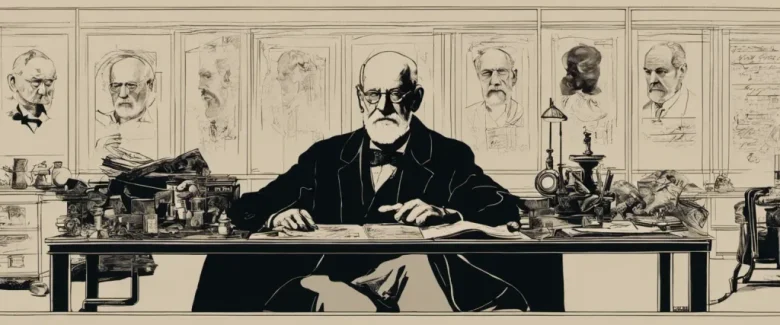In “Freud: A Life for Our Time,” Peter Gay presents a comprehensive biography of Sigmund Freud, delving into the life and work of the iconic psychoanalyst who revolutionized our understanding of the human mind. Through a meticulous examination of Freud’s upbringing, significant relationships, and groundbreaking theories, Gay provides readers with an in-depth exploration of the man behind the influential psychoanalytic movement. Peter Gay, born in 1923, was a renowned historian and social critic who dedicated his career to studying the history of ideas and shaping our understanding of various intellectual figures. As a highly esteemed author and a leading authority on Freud, Gay’s account offers readers a balanced and insightful portrayal of the complex life and work of the father of psychoanalysis.
Chapter 1: Introduction to Sigmund Freud
Chapter 1 of the book “Freud” by Peter Gay provides an introduction to the influential psychologist Sigmund Freud and his groundbreaking theories. The chapter begins by highlighting the widespread impact Freud had on various fields such as psychology, literature, and art, making him one of the most significant thinkers of the 20th century.
Gay then explores Freud’s background, describing his upbringing in Vienna, Austria, in the late 19th century. As the son of Jewish parents, Freud faced some societal prejudice but managed to excel academically and pursue a career in medicine. It is during his medical studies that Freud developed a keen interest in the human mind and its complexities.
The chapter also introduces Freud’s close colleagues and collaborators, including Josef Breuer, who played a crucial role in shaping Freud’s theories. Freud was heavily influenced by two key events: his encounter with Jean-Martin Charcot’s work on hysteria, leading to Freud’s belief that psychiatric disorders were rooted in the unconscious, and his realization that his patients’ symptoms could be traced back to repressed memories.
Gay presents Freud’s development of psychoanalysis as a revolutionary approach, emphasizing its focus on the unconscious mind. Freud’s notion of the three-part psychic structure, composed of the id, ego, and superego, is explained, as are his ideas on dream interpretation and the significance of sexual and aggressive drives. The chapter concludes with a discussion on Freud’s devotion to the scientific method and his desire to establish psychoanalysis as a legitimate scientific discipline.
In summary, Chapter 1 serves as an introduction to Sigmund Freud, his background, and the key foundations of his revolutionary theories in psychoanalysis, which challenged conventional understanding of the human mind and behavior.
Chapter 2: The Early Years
In Chapter 2 of the book “Freud: A Life for Our Time” by Peter Gay, titled “The Early Years,” the focus is on Sigmund Freud’s childhood and upbringing. The chapter sheds light on the influences and experiences that shaped the future revolutionary psychologist.
Freud was born in Freiberg, a small town in Moravia, part of the Austro-Hungarian Empire. His father, Jacob, was a merchant with a keen interest in education, while his mother, Amalia, came from a traditional Jewish family. Freud had seven siblings, and he grew up in a modest, but nurturing household.
During his early years, Freud showed signs of intellectual brilliance and exhibited a deep curiosity about the workings of the human mind. He was a voracious reader and was greatly influenced by his studies of philosophy, mythology, and literature. These early interests laid the foundation for his later groundbreaking theories.
Notably, the chapter also explores Freud’s complicated relationship with his parents, especially his mother. Amalia’s overprotectiveness and desire to keep her children close created an emotionally charged environment that may have contributed to Freud’s future focus on psychoanalysis and the mother-child relationship.
The chapter also discusses Freud’s education, which was both rigorous and diverse. He studied various subjects, including science and medicine, but ultimately, his fascination with the human mind and psychiatric disorders drove him towards a career in psychology and psychiatry.
Overall, Chapter 2 of Peter Gay’s biography of Freud provides an insightful exploration of the formative years of a man who would go on to revolutionize our understanding of human psychology. It highlights Freud’s early intellectual development, the influence of his parents, especially his mother, and his diverse educational background, all of which played crucial roles in shaping his future theories and groundbreaking work.
Chapter 3: The Birth of Psychoanalysis
Chapter 3: The Birth of Psychoanalysis, from the book Freud by Peter Gay, reveals the emergence of Sigmund Freud as a prominent figure in the field of psychoanalysis. This chapter explores the development of Freud’s ideas and the key events leading up to his groundbreaking theories.
The chapter begins by examining Freud’s early life, exploring his childhood, education, and medical training. This background is essential to understanding the influences and experiences that would shape his thinking. Freud’s interactions with his mentor, Jean-Martin Charcot, and his fascination with hypnosis, are highlighted as fundamental in the formation of his groundbreaking theories.
The narrative then explores Freud’s significant contributions to psychoanalysis. One milestone is his collaboration with Josef Breuer on the famous case study of “Anna O”, which introduced the concept of “talking therapy” and laid the foundation for psychoanalytic methods. Freud’s groundbreaking notion of the unconscious mind is also introduced, along with the importance of dreams and their interpretation in understanding psychological processes.
Additionally, the chapter delves into Freud’s work on sexuality and his theory of the Oedipus complex, which stirred controversy and challenged societal norms. His discussions on repressed desires, sexual fantasies, and the significance of childhood experiences in shaping adult personalities are presented as key components of his revolutionary ideas.
Overall, Chapter 3 illustrates Freud’s transformative journey from a young medical student to a trailblazing thinker who revolutionized the fields of psychology and psychiatry. It highlights his discoveries, collaborations, and meticulously developed theories, showcasing his early contributions to the birth of psychoanalysis and the subsequent impact his work had on the understanding of the human mind.
Chapter 4: The Interpretation of Dreams

Chapter 4 of the book “Freud” by Peter Gay focuses on Sigmund Freud’s most iconic work, “The Interpretation of Dreams.” In this chapter, Gay highlights the significance of this seminal text and delves into its key themes and ideas.
“The Interpretation of Dreams” was published in 1899 and marked a turning point in the development of psychoanalysis. Freud argued that dreams are meaningful and symbolic, representing the fulfillment of hidden desires and unfulfilled wishes. He posited that dreams serve as a disguised expression of our repressed unconscious thoughts and conflicts.
One of the central concepts in Freud’s book is that dreams contain both manifest and latent content. The manifest content refers to the literal events and images that occur in a dream, while the latent content represents the underlying, often symbolic, meaning.
Freud introduced the idea of the Oedipus complex in this work, a psychological theory based on Greek mythology. He claimed that during childhood, all individuals experience unconscious feelings of desire for their opposite-sex parent and jealousy towards their same-sex parent. These repressed desires, according to Freud, manifest in dreams.
Furthermore, Freud discussed the technique of dream interpretation, emphasizing the importance of free association and the analysis of symbolism. He believed that uncovering the hidden meanings in dreams could provide valuable insight into the individual’s unconscious and help to resolve internal conflicts.
Overall, “The Interpretation of Dreams” revolutionized the field of psychology by introducing the concept of the unconscious mind and emphasizing the significance of dreams. Freud’s work laid the foundation for psychoanalysis and influenced a wide range of fields, from literature to art, by exploring the depths of the human psyche.
Chapter 5: Psychoanalysis in Practice
Chapter 5 of the book Freud by Peter Gay, titled “Psychoanalysis in Practice,” delves into the practical aspects of Sigmund Freud’s groundbreaking psychological technique. Building upon the theoretical foundations laid out in previous chapters, this section examines the key elements and methods employed by Freud in his psychoanalytic practice.
Gay outlines how Freud refined his therapeutic technique, utilizing free association as a fundamental tool. Clients would relax in a comfortable setting and verbally share their thoughts, allowing their unconscious mind to freely express itself. Freud believed that this method allowed access to repressed desires, memories, and conflicts.
The concept of transference is also explored in this chapter. Freud found that clients often projected their feelings, particularly unresolved childhood conflicts, onto the therapist. By analyzing these transference patterns, he aimed to uncover the underlying issues and provide therapeutic resolution. Freud further introduced the concept of countertransference, acknowledging the emotional reactions of analysts towards their clients.
Gay also discusses Freud’s interpretation of dreams and how they served as an access point to the unconscious. Dreams, he believed, were the result of unfulfilled desires or unconscious conflicts seeking expression. Through a careful analysis of dream symbolism and hidden meanings, Freud aimed to uncover the unconscious thoughts underlying these dreams.
In addition to dream analysis, Freud pioneered the technique of interpreting slips of the tongue or “Freudian slips.” These seemingly innocuous mistakes in speech were believed to reveal unconscious thoughts or repressed desires that the speaker may not have been fully aware of.
Overall, Chapter 5 provides an in-depth exploration of the practical applications of Freud’s psychoanalytic method, highlighting its focus on free association, transference, dream analysis, and interpreting slips of the tongue to bring unconscious conflicts into conscious awareness for therapeutic resolution.
Chapter 6: Criticisms and Controversies
Chapter 6 of the book “Freud” by Peter Gay explores the criticisms and controversies surrounding the work of Sigmund Freud. The chapter delves into the various perspectives and objections raised by Freud’s contemporaries, as well as subsequent generations of critics.
Gay begins by highlighting the criticism that Freud’s theories lacked scientific rigor and empirical evidence. Many scientists and philosophers regarded his psychoanalytic approach as unscientific due to its heavy reliance on subjective interpretation and the inability to conduct controlled experiments. Critics argued that Freud’s theories were more akin to speculation and myth-making rather than true science.
Another prominent criticism examined in the chapter is Freud’s treatment of women. Critiques of Freud’s views on femininity highlighted his tendency to pathologize female sexuality and attribute women’s psychological experiences solely to penis envy. Gay notes that Freud’s emphasis on the Oedipus complex and the castration anxiety faced by boys overshadowed his understanding of female sexuality and development.
Furthermore, Gay addresses the criticism that Freud’s theories were overly deterministic and reductionist. Critics argued that Freud’s emphasis on unconscious drives and instincts disregarded the role of free will and individual agency in shaping human behavior.
Additionally, Gay explores the controversies surrounding Freud’s views on religion and his interpretation of dreams. Religious critics found Freud’s psychoanalysis to be incompatible with their beliefs, deeming it atheistic and reductionist. Moreover, some critics questioned the universality and interpretive capabilities of dream analysis, challenging the plausibility of Freud’s claims.
In summary, Chapter 6 of “Freud” delves into the multiple criticisms and controversies that have surrounded Freud’s work and theories. These critiques range from his lack of scientific methodology and dependence on subjective interpretation to his treatment of women, deterministic approach, and challenges to his views on religion and dream analysis.
Chapter 7: Freud’s Legacy
Chapter 7 of the book “Freud” by Peter Gay discusses Freud’s legacy and the impact his theories and ideas have had on various disciplines and society as a whole. The chapter begins by highlighting how Freud’s theories were met with hostility and skepticism during his time. However, despite the initial resistance, his ideas gained significant traction and continue to influence fields like psychology, literature, art, and cultural studies.
One notable aspect of Freud’s legacy is his theory of the unconscious mind. Freud proposed that the mind is divided into conscious and unconscious parts, with the latter influencing our thoughts and behaviors in ways we may not be aware of. This idea revolutionized psychology, leading to the development of psychoanalysis as a therapeutic approach. Furthermore, it influenced literary theory, as authors explored the depths of the human psyche in their works.
Another significant aspect of Freud’s legacy is his emphasis on sexuality. Freud believed that our sexual drives and desires play a fundamental role in shaping our personalities and behavior. This idea challenged prevailing social and moral norms, but it opened up discussions on sexuality and paved the way for later theories and studies on human sexual behavior.
Furthermore, Freud’s ideas contributed to the understanding of dreams as a manifestation of hidden desires. He argued that dreams serve as a means of wish fulfillment and provide insight into our unconscious thoughts. This concept has had a lasting impact on the field of dream analysis and its applications in various areas such as self-exploration and psychotherapy.
Overall, Freud’s legacy lies in his groundbreaking theories on the unconscious mind, human sexuality, and the interpretation of dreams. His ideas continue to shape and influence numerous fields, challenging traditional beliefs and leading to a greater understanding of the complexity of human psychology and behavior.

Chapter 8: Conclusion
Chapter 8: Conclusion of the book “Freud” by Peter Gay provides a comprehensive overview of Sigmund Freud’s life, work, and impact on the field of psychology. It demonstrates Freud’s immense influence as a pioneering figure, whose theories and discoveries revolutionized the understanding of the human mind.
The author begins by discussing Freud’s belief in the importance of human sexuality as a driving force behind human behavior. Freud’s emphasis on the unconscious and the power of repressed desires challenged conventional views and sparked controversy. Despite facing criticism and opposition, Freud’s groundbreaking concepts, such as the id, ego, superego, and the psychosexual stages, permanently transformed the field of psychology.
The chapter further explores Freud’s struggle with personal matters, including his difficult relationship with his father and his battles with health issues. Despite these challenges, Freud remained a dedicated and persistent researcher, never shying away from controversial topics.
Additionally, the chapter delves into Freud’s relationship with his disciples and colleagues, highlighting the significance of his inner circle, which played a crucial role in advancing his theories and popularizing psychoanalysis.
Gay concludes the book by discussing Freud’s legacy and the continued relevance of his ideas in contemporary psychology. He acknowledges the limitations and flaws in some of Freud’s theories, yet emphasizes the enduring impact and contributions he made to the understanding of the human psyche. Freud’s influence extended beyond academic circles, permeating popular culture and shaping societal attitudes towards sexuality and mental health.
In summary, this final chapter of “Freud” serves as a testament to Sigmund Freud’s profound impact on the field of psychology. It highlights his significant contributions, explores his personal struggles, and concludes with an examination of his enduring legacy.
After Reading
In conclusion, Peter Gay’s book “Freud” provides a comprehensive and insightful overview of the life and work of Sigmund Freud. Through a meticulous examination of Freud’s theories, discoveries, and personal experiences, Gay presents a balanced portrayal of the influential figure who forever changed the field of psychology. While acknowledging Freud’s significant contributions, Gay also critically evaluates some of his controversial ideas and practices. Overall, “Freud” sheds light on both the brilliance and the complexity of this pioneering thinker, making it a valuable resource for anyone seeking to understand the man behind the psychoanalytic movement.
1. Sapiens: A Brief History of Humankind” by Yuval Noah Harari
This book provides a fascinating exploration of the history of our species, Homo sapiens, as well as how we have come to dominate the world. Harari combines historical, scientific, and philosophical perspectives to examine our journey from the Stone Age to the present, making it a thought-provoking and enlightening read.
2. Man’s Search for Meaning” by Viktor E. Frankl
Based on his own experiences as a Holocaust survivor, Frankl explores the concept of finding meaning and purpose in life even amidst immense suffering. This profound book offers a unique perspective on human resilience, exuding hope and providing insightful reflections on the human spirit.
3. The Power of Now: A Guide to Spiritual Enlightenment” by Eckhart Tolle
In this transformative work, Tolle imparts his spiritual teachings, emphasizing the importance of living in the present moment to find true peace and self-realization. It provides practical advice and encourages readers to let go of unnecessary worries and anxieties, making it a powerful tool for personal growth.
4. The Alchemist” by Paulo Coelho
This enchanting novel follows the journey of a young Andalusian shepherd as he travels across the desert in search of a hidden treasure. The story beautifully explores themes of destiny, purpose, and personal growth, inspiring readers to pursue their dreams and listen to their hearts. With its lyrical prose and profound insights, it has become a modern classic.
5. “Meditations” by Marcus Aurelius
A collection of philosophical reflections by the Roman Emperor Marcus Aurelius, “Meditations” underscores the importance of leading a virtuous life while facing the challenges of the world. Aurelius’ stoic philosophy provides valuable insights into self-reflection, resilience, and the pursuit of wisdom, making it a timeless and indispensable read.




Comments
Pingback: The Inner Game of Tennis: A Guide to Mental Mastery on the Court - Booksplease
Pingback: The Crowd: Exploring the Dynamics of Collective Mindset - Booksplease